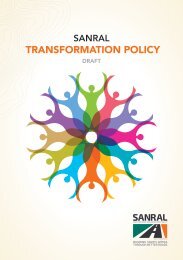Brand-South Africa - Annual report 2015 - 2016
During the past financial year, aligned with its mandate to build pride and patriotism in the Nation Brand, Brand South Africa has worked on initiatives to encourage active citizenship in partnership with its stakeholders in government, business, civil society and identified influential forums to increase the participation of all people, particularly our young people, in building a strong, cohesive Nation Brand. These activities, together with engagements at provincial level on Nation Brand alignment, contribute to social cohesion and a positive Nation Brand. Brand South Africa’s activities took place under the leadership of its new CEO, Amb. Kingsley Makhubela, PhD, who joined the organisation during the year.
During the past financial year, aligned with its mandate to build pride and patriotism in the Nation Brand, Brand South Africa has worked on initiatives to encourage active citizenship in partnership with its stakeholders in government, business, civil society and identified influential forums to increase the participation of all people, particularly our young people, in building a strong, cohesive Nation Brand. These activities, together with engagements at provincial level on Nation Brand alignment, contribute to social cohesion and a positive Nation Brand.
Brand South Africa’s activities took place under the leadership of its new CEO, Amb. Kingsley Makhubela, PhD, who joined the organisation during the year.
You also want an ePaper? Increase the reach of your titles
YUMPU automatically turns print PDFs into web optimized ePapers that Google loves.
Recognition<br />
An inflow of resources from a non-exchange transaction<br />
recognised as an asset is recognised as revenue, except to<br />
the extent that a liability is also recognised in respect of the<br />
same inflow.<br />
As <strong>Brand</strong> SA satisfies a present obligation recognised as a<br />
liability in respect of an inflow of resources from a non-exchange<br />
transaction recognised as an asset, it reduces the carrying<br />
amount of the liability recognised and recognises an amount<br />
of revenue equal to that reduction.<br />
Measurement<br />
Revenue from a non-exchange transaction is measured at the<br />
amount of the increase in net assets recognised by <strong>Brand</strong> SA.<br />
When, as a result of a non-exchange transaction, <strong>Brand</strong> SA<br />
recognises an asset, it also recognises revenue equivalent to<br />
the amount of the asset measured at its fair value as at the<br />
date of acquisition, unless it is also required to recognise a<br />
liability. Where a liability is required to be recognised it will<br />
be measured as the best estimate of the amount required to<br />
settle the obligation at the <strong>report</strong>ing date, and the amount of<br />
the increase in net assets, if any, recognised as revenue. When<br />
a liability is subsequently reduced, because the taxable event<br />
occurs or a condition is satisfied, the amount of the reduction<br />
in the liability is recognised as revenue.<br />
1.14 Investment income<br />
Investment income is recognised on a time-proportion basis<br />
using the effective interest method.<br />
1.15 Borrowing costs<br />
Borrowing costs are interest and other expenses incurred by<br />
an entity in connection with the borrowing of funds.<br />
Borrowing costs are recognised as an expense in the period<br />
in which they are incurred.<br />
1.16 Translation of foreign currencies<br />
Foreign currency transactions<br />
A foreign currency transaction is recorded, on initial recognition<br />
in Rand, by applying to the foreign currency amount, the spot<br />
exchange rate between the functional currency and the foreign<br />
currency at the date of the transaction.<br />
At each <strong>report</strong>ing date:<br />
• foreign currency monetary items are translated using<br />
the closing rate;<br />
• non-monetary items that are measured in terms of<br />
historical cost in a foreign currency are translated using<br />
the exchange rate at the date of the transaction; and<br />
• non-monetary items that are measured at fair value in a<br />
foreign currency are translated using the exchange rates<br />
at the date when the fair value was determined.<br />
Exchange differences arising on the settlement of monetary<br />
items or on translating monetary items at rates different from<br />
those at which they were translated on initial recognition during<br />
the period or in previous Financial Statements are recognised<br />
in surplus or deficit in the period in which they arise.<br />
When a gain or loss on a non-monetary item is recognised<br />
directly in net assets, any exchange component of that gain<br />
or loss is recognised directly in net assets. When a gain or loss<br />
on a non-monetary item is recognised in surplus or deficit,<br />
any exchange component of that gain or loss is recognised<br />
in surplus or deficit.<br />
Cash flows arising from transactions in a foreign currency are<br />
recorded in Rand by applying to the foreign currency amount<br />
the exchange rate between the Rand and the foreign currency<br />
at the date of the cash flow.<br />
1.17 Fruitless and wasteful expenditure<br />
Fruitless expenditure means expenditure which was made<br />
in vain and would have been avoided had reasonable care<br />
been exercised.<br />
All expenditure relating to fruitless and wasteful expenditure<br />
is recognised as an expense in the statement of Financial<br />
performance in the year that the expenditure was incurred. The<br />
expenditure is classified in accordance with the nature of the<br />
expense, and where recovered, it is subsequently accounted<br />
for as revenue in the statement of Financial performance.<br />
1.18 Irregular expenditure<br />
Irregular expenditure as defined in Section 1 of the PFMA is<br />
expenditure other than unauthorised expenditure, incurred in<br />
contravention of or that is not in accordance with a requirement<br />
of any applicable legislation, including -<br />
(a) this Act; or<br />
(b) the State Tender Board Act, 1968 (Act No. 86 of 1968), or<br />
any regulations made in terms of the Act; or<br />
(c) any provincial legislation providing for procurement<br />
procedures in that provincial government.<br />
National Treasury practice note no. 4 of 2008/2009 which was<br />
issued in terms of sections 76(1) to 76(4) of the PFMA requires<br />
the following (effective from 1 April 2008):<br />
Irregular expenditure that was incurred and identified during<br />
the current financial year and which was condoned before year<br />
end and/or before finalisation of the Financial Statements must<br />
also be recorded appropriately in the irregular expenditure<br />
register. In such an instance, no further action is also required<br />
with the exception of updating the note to the Financial<br />
Statements.<br />
Irregular expenditure that was incurred and identified during<br />
the current financial year and for which condonement is<br />
being awaited at year end must be recorded in the irregular<br />
expenditure register. No further action is required with the<br />
exception of updating the note to the Financial Statements.<br />
101











